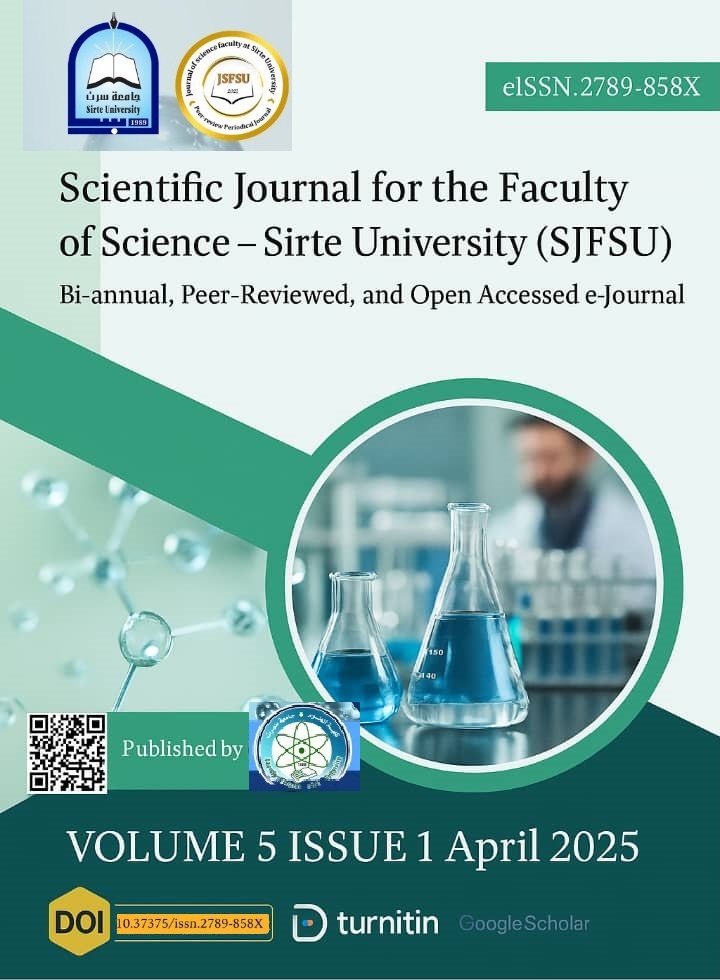Sulphur, Organic Carbon, Organic Nitrogen, Iron Relationships and Diagenesis of Black Shales in Tenom and Ranau Regions , West Sabah, Malaysia.
DOI:
https://doi.org/10.37375/sjfssu.v5i1.3039Keywords:
anoxic environment, carbonaceous sediments, Kerogen, pyrite framboids, Sulfur,Abstract
The sediments investigated in this paper constitute part of the Temburong and Trusmadi formations outcropping in the Tenom and Ranau area located in the Western part of Sabah state, Malaysia. The aims of this paper were to analyzed and determine the various forms of (organic and inorganic sulphur), organic carbon, organic nitrogen, iron, total sulphur, and pyrite sulphur which was determined in two organic fractions (bitumen and kerogen) as well as in the total rock of these carbonaceous sediments, and also to assess the relationships between C, S, and N content in the early stage of microbial diagenesis of the studied black shales. The bulk geochemistry concentration, especially the C-S relationships, showed the important role of reactive iron in controlling the extent of pyrite formation. The high values of the degree of pyritization (DOP) which ranges from 0.99 to 1.0 suggested that iron has been exhausted by pyrite formation (i.e. iron- limited conditions) in all the study samples. The reduced sulphur in these study samples increases with burial depth and time. This pattern suggested the continuous diagenetic addition of reduced sulphur under conditions where the time and depth of burial are related. Kerogen appears to be uniform in N and S content, but both components vary in bitumen. N contents in bitumen show no covariance with any other parameters, but bitumen always has a much higher C/N ratio than kerogen. The presence of pyrite framboids is an additional evidence for poorly oxygenated (anoxic) bottom waters depositional environment.
References
Berner, R. A. (1964). Distribution and diagenesis of sulfur in some sediments from the Gulf of California. Marine Geology, 1(2), 117–140. https://doi.org/10.1016/0025-3227(64)90011-8
Berner, R. A. (1970). Sedimentary pyrite formation. American Journal of Science, 268(1), 1–23. https://doi.org/10.2475/ajs.268.1.1
Berner, R. A. (1972). Sulfate reduction pyrite formation and the oceanic budget. In Dyrssen, D. & Janger, D. (ed.) Nobel Symposium 20, the changing Chemistry of the Ocean. Almquist and Wiksell, Socholm. 437-361.
Berner, R. A. (1980). Early Diagenesis and Theoretical Approach. Princeton Univ. Press.
Berner, R. A. (1984). Sedimentary pyrite formation: An update. Geochimica Et Cosmochimica Acta, 48(4), 605–615. https://doi.org/10.1016/0016-7037(84)90089-9
Bromfield, S. M., & Williams, E. G. (1963). An examination of the biological reduction method for estimating active iron in soils. Journal of Soil Science, 14(2), 346–359. https://doi.org/10.1111/j.1365-2389.1963.tb00958.x
Collenette, P., (1965). The geology and mineral resources of the Pensiabgan and Upper Kinabatangan area, Sabah, Malaysia. Geological Survey Borneo Region, Malaysia, Memoir 12.
Filipek, L. H. & Owen, R. M. (1980). Early diagenesis of organic carbon and sulphur in the outer shelf sediments from the Gulf of Mexico. American Journal of Science 280:1097-1112.
Goldhaber, M. B. & Kaplan, I. R. (1975). Controls and consequences of sulfate reduction rates in recent marine sediments. Soil Science 119:42-55.
Goldhaber, M. B.& Kaplan, I. R. (1980). Mechanism of sulphur incorporation and isotope fractionation during early diagenesis in sediments of the Golf of California. Marine chemistry 9: 95-143.
Goldhaber, M. B., Aller, R. G., Cochran, J. K., Rosenfeld, J. K., Martens, C. S. & Berner, R. A. (1977).
Sulphate reduction, diffusion and bioturbation in Long Island Sound sediments. Report of the Foam group. American Journal of Science 277: 193-237.
Goldhaber, M. B., and Kaplan, I. R. (1974). The sulphur cycle. In Goldberg, E. D. (ed.). The Sea 5, Willey, New Yourk 569-655.
Hutchison, C.S. (2005). Geology of North-West Borneo: Sarawak, Brunei and Sabah.Hydrocarbons of biological origin from one- billion-year sediments.
Jacobson, G. (1970). Gunong Kinabalu area, Sabah, Malaysia. Geological Survey of Malaysia Report, 8.
Jorgensen, B. B. (1978). A comparison of methods for the quantification of bacterial sulfate reduction in coastal marine sediments. Geomicrobiology Journal, 1(1), 11-27.
Lee, C. P. (1977). The geology of Labuan Island, Sabah, East Malysia. BSc. Thesis. University of Malaya, Malaysia.
Leong, K. M. 1999. Geological setting of Sabah, In Petronas (ed.). The Petroleum Geology and Resources of Malaysia. pp.675–497.
Levell, B. (1987). The nature and significance of regional unconformities in the hydrocarbon-bearing Neogene sequence offshore West Sabah. Bulletin of the Geological Society of Malaysia, 21, 55–90. https://doi.org/10.7186/bgsm21198704
Love, L. G. (1967). Early diagenetic iron sulphide in recent sediments of the Wash (England). Sedimentology, 9(4), 327-352.
Love, L. G. & Amstutz, G. C. (1966). Review of microscopic pyrite. Fortschritte der Mineralogie, 43, 273-309.
Mohamed MD Tan, 1985. Aspects of carbon, Nitrogen and Sulphur Diagenesis in sediments. PhD thesis. University of East Anglia.
Müller, P. J. (1977). CN ratios in Pacific deep-sea sediments: Effect of inorganic ammonium and organic nitrogen compounds sorbed by clays. Geochimica et Cosmochimica Acta, 41(6), 765-776.
Sweeney, R. E. & Kaplan, I. R. (1973). Pyrite framboid formation: Laboratory synthesis and marine sediments. Economic Geology 68: 618-634.
Wedepohl, K. H. (1969). Handbook of Geochemistry. Vol 1 SpringerVerlag, Berlin, p 4

Downloads
Published
Issue
Section
License
Copyright (c) 2025 Scientific Journal for Faculty of Science-Sirte University

This work is licensed under a Creative Commons Attribution 4.0 International License.













